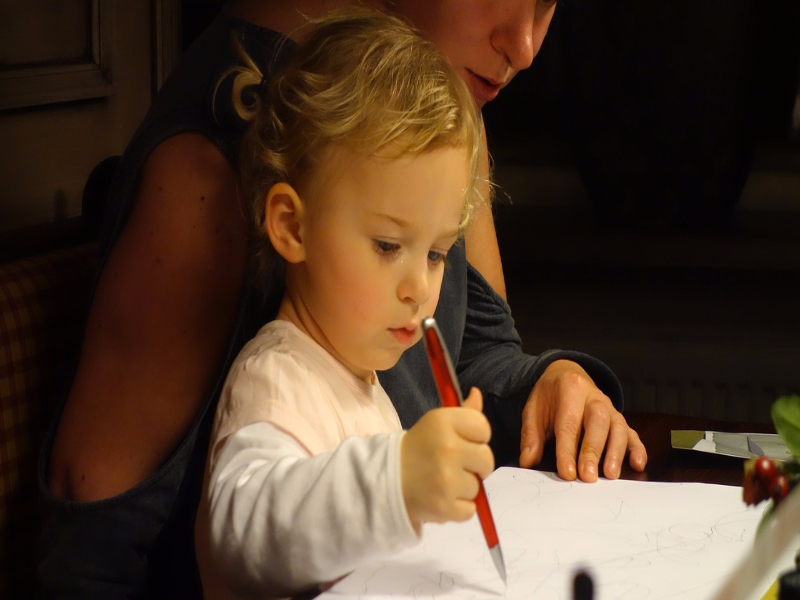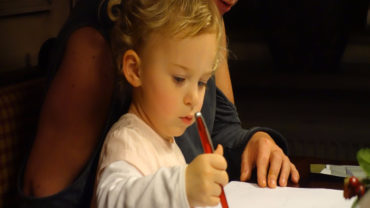Via Parents: 5 Ways Grown-Ups Squelch Kids’ Creativity
What are parents and teachers doing to stop kids’ imaginations in their tracks? These experts, A-list actors, and modern parents reveal the top creativity-stoppers.
Building Blocks of Creativity
Where does creativity come from? And at what age does it go from plain ‘ol being silly to actually becoming the driving force behind astounding, inventive ideas?
Actor Matthew Broderick touts basic wooden blocks as being the foundation of his own creativity, which he now culls on-screen and on-stage. As a kid in a Manhattan private school, there were no toy cars or train sets — only blocks. “The idea that you could make toys yourself and not having ones already designed [for you] was a very profound thing,” he says.
As a dad himself to young son James (who now goes to his father’s alma mater), Broderick relishes the unstructured time the two of them spend getting creative together. Whether it’s building and knocking down towers or just “lying on the floor and staring up at the ceiling,” Broderick is serious about helping his son get his creative wheels turning — on James’ terms. “I like to let him decide what we use that time for,” Broderick says.
Time for Creating — and Dreaming
But how do non-Broadway types set their family’s creative motors to zoom? A company synonymous with kids’ exploratory endeavors, LEGO, is offering one idea: Take an hour every day to play — without expectations or ground rules. Kids need parents to back up their efforts to imagine and embrace discovery; parents could use a little time to just wonder, themselves.
It seems fitting that LEGO, a company whose name appropriately means “play well” in Danish, would sponsor such an initiative. But what happens when parents’ best intentions of working their child’s brain gets out of control? Check out these top mistakes parents make that actually burn out — not boost, as they might hope — kids’ creativity.
Overscheduling Is a No-No
Squelcher #1: Keep ‘Em Booked
“It’s easy to schedule our kids, because we think it’s better than [letting them] do nothing,” says Heather Reider, co-CEO of MomsTown, Inc., a media group that produces parenting books and broadcasts. “But really, maybe doing nothing is the best thing for them.”
Of course, some extracurricular activities can be major brain-boosters for kids, and offer the opportunity to explore some of the interests they have that don’t get touched upon during the school day. But practice-to-meeting-to-class-to-field schedules often don’t give kids the chance to appreciate what they’re gaining from each individual activity. Parents need to ask themselves: Is the idea of being in a Spanish language group or a ballroom dance class the main reason your child is involved in those activities — or does he actually dig what he’s learning?
How to monitor activity overload:
- Constantly check in with your kids about their schedule. Are there things they’re just not having fun with anymore? Let those be the first classes or sports to drop.
- Gauge what they’re learning by simply asking, and present them with the opportunity to look like the expert: “You know, I’ve never taken a drawing class. Can you show me some of the things your teacher has you practice?”
- Remember that extracurriculars can exist informally, too. If your child is talking about taking some astronomy classes at a local science center, take a few trips there with him, first. He may just be interested in the overall topic, which could be sated without months of scheduled classroom time.
- Reserve time to do nothing. Schedule a little sloth time each month — a Pajama Saturday, maybe, or a weekday afternoon lying on the lawn.
Managing Homework & Expectations
Squelcher #2: Allow Excess Homework
No, you shouldn’t flat-out refuse to let your child complete his take-home assignments, but when your evenings are being eaten up by hours of worksheets and studying — and when your child’s frustration level is skyrocketing nightly — it’s okay to put your foot down.
That’s what Reider did. “I finally had to say to my son’s teacher, ‘We value our time as a family.'” The mother of three says that it’s necessary to convey to teachers what’s reasonable for kids: Not only does it alleviate unnecessary academic stressors (and resulting emotional and physical anguish) for your child, but it also opens up time that your family can spend time learning and creating and playing together.

Squelcher #3: Expect Perfection
It’s like the whole color-in-the-lines debate: Do kids need to be taught that art only exists within the boundaries of coloring books? Should they be penalized if their arts and crafts get a little, well, crafty?
“I’d rather look at an auditorium full of first-grade paper turkeys than a room full of beautiful ones done by parents,” Reider says. When it comes down to it, grown-ups need to resist the urge to channel kids’ interests for them, and make peace with letting them explore. That may mean less-than-stellar paper turkeys, failed basement rock bands, or dashed attempts at learning to knit — and that’s okay. Because even if his passion doesn’t pan out as a strong skill, you’ve shown your child it’s crucial to try.
How to discourage “blah” ideas:
- Let kids make a mess — a huge one. Curb your instincts to tell them to keep it clean, and give them a confined space they can trash, but later clean up. Talk about what they make or, better yet, throw on some play clothes yourself and join in.
- Give them tools to get creative with. “Construction paper, crayons, glue sticks, markers, blocks, LEGO bricks,” writes Reider and co-author Mary Goulet. “If kids have the right tools they can create all kinds of imaginative sculptures and artwork.”
Control Issues, Staying Creative
Squelcher #4: Make “No, Do It This Way” a Mantra
It’s a creatively deadly phrase, says Dr. Meri Cummings, a science resource teacher in a NASA-sponsored Classroom of the Future. As an instructor who structures classes so that teachers are a guide on the side and the students, themselves, are setting the procedures, Cummings is adamant about imparting that there’s no “right” way to do most things. Implying that there is just keeps kids from taking creative risks — a major sap for inventive thinking.
Matthew Broderick agrees, and emphasizes that for decades, kids have done just fine making decisions without formal processes. He uses his stickball-playing days as a kid as proof: “There were no coaches, no umpires. We had to decide how six kids would play nine positions.” And they did — their own way.
Squelcher #5: Abandon Creativity Yourself
Truly, the easiest way to convince a kid that creativity is a hoax and just a school buzzword is for parents to abandon it, themselves. “If you immerse yourself in creative pursuits, your kids will see it and you will provide a great model,” the MomsTown founders write.
Sounds simple, but how do you tap back into your inner kindergartener? Unplug. Turn on your favorite music, and plop down with your kids. Follow their lead, and get messy or rowdy or silly — better yet, be all of those things. Creativity, after all, is what guided us through our most formative years, and it’s just not something that adults need to abandon.



